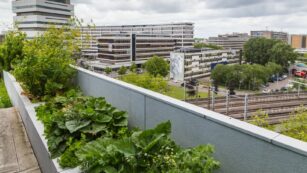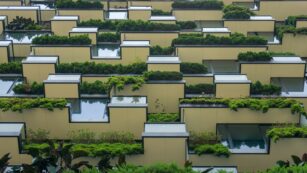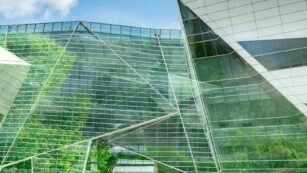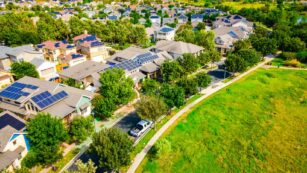As the world grapples with climate change and environmental degradation, sustainable building construction emerges as a pivotal solution. This approach not only reduces the environmental footprint of buildings but also enhances their efficiency and longevity. By integrating eco-friendly materials and innovative design techniques, sustainable construction aims to meet today’s infrastructure needs without compromising the ability of future generations to meet their own.
Sustainable Building Construction
Sustainable building construction integrates practices that significantly minimize the negative environmental impacts of buildings while enhancing their performance and occupant well-being. Key strategies include the use of energy-efficient technologies, sustainable materials, and innovative construction techniques.
Energy Efficiency
 Energy-efficient designs and technologies reduce the amount of energy buildings require for heating, cooling, lighting, and operating appliances. Implementing solar panels, high-performance windows, and advanced insulation are common practices that contribute to lower energy consumption. Buildings designed under the LEED certification standards exemplify high energy efficiency.
Energy-efficient designs and technologies reduce the amount of energy buildings require for heating, cooling, lighting, and operating appliances. Implementing solar panels, high-performance windows, and advanced insulation are common practices that contribute to lower energy consumption. Buildings designed under the LEED certification standards exemplify high energy efficiency.
Use of Sustainable Materials
The choice of materials significantly affects a building’s sustainability. Sustainable construction favors materials that are recycled, renewable, or sourced from local suppliers to reduce the carbon footprint. Examples include bamboo, recycled steel, and reclaimed lumber. These materials reduce the environmental strain from resource extraction and decrease construction waste.
Benefits of Adopting Sustainable Building Techniques
Sustainable building techniques play a pivotal role in boosting environmental and economic sustainability in the construction sector. They provide measurable improvements in building performance and occupant well-being.
Environmental Impact
 Adopting sustainable building techniques dramatically reduces the ecological footprint of construction projects. By using materials such as bamboo and recycled steel, these methods lower greenhouse gas emissions and reduce the extraction of virgin resources. Additionally, energy-efficient technologies like solar panels and high-performance insulation massively decrease a building’s energy consumption. For instance, solar panels convert sunlight into electricity, reducing dependence on fossil fuels and mitigating pollution.
Adopting sustainable building techniques dramatically reduces the ecological footprint of construction projects. By using materials such as bamboo and recycled steel, these methods lower greenhouse gas emissions and reduce the extraction of virgin resources. Additionally, energy-efficient technologies like solar panels and high-performance insulation massively decrease a building’s energy consumption. For instance, solar panels convert sunlight into electricity, reducing dependence on fossil fuels and mitigating pollution.
Long-Term Economic Savings
 Sustainable building practices yield significant long-term economic benefits. Initially, they may involve higher upfront investment, yet they significantly reduce utility and maintenance costs over the building’s lifecycle. Energy-efficient appliances and sustainable materials often come with lower energy costs and fewer maintenance requirements. A building equipped with LED lighting and advanced HVAC systems, for example, uses less energy, which translates into lower monthly utility bills. Moreover, sustainable buildings typically have higher property values and attract tenants more easily, enhancing their investment return.
Sustainable building practices yield significant long-term economic benefits. Initially, they may involve higher upfront investment, yet they significantly reduce utility and maintenance costs over the building’s lifecycle. Energy-efficient appliances and sustainable materials often come with lower energy costs and fewer maintenance requirements. A building equipped with LED lighting and advanced HVAC systems, for example, uses less energy, which translates into lower monthly utility bills. Moreover, sustainable buildings typically have higher property values and attract tenants more easily, enhancing their investment return.
Challenges in Sustainable Building Construction
Sustainable building construction faces several challenges despite its numerous benefits and rapidly growing adoption. These challenges often involve high costs, regulatory hurdles, and technological limitations, which can impede progress.
High Initial Costs
Implementing sustainable building technologies and materials typically incurs higher initial costs compared to traditional construction methods. For instance, integrating high-performance insulation, advanced HVAC systems, and solar panels increases upfront expenditures. Buildings utilizing materials like bamboo and recycled steel also face cost premiums due to their specialized production processes and limited availability. However, these investments usually pay off with lower utility and maintenance costs over the building’s lifecycle.
Regulatory and Policy Challenges
 Navigating the complex landscape of governmental regulations and building codes presents another significant hurdle. Many regions lack specific guidelines that support sustainable building practices, which can deter builders from pursuing these options. Additionally, obtaining necessary permits for innovative construction techniques, such as the installation of greywater systems, can be time-consuming and fraught with bureaucratic delays.
Navigating the complex landscape of governmental regulations and building codes presents another significant hurdle. Many regions lack specific guidelines that support sustainable building practices, which can deter builders from pursuing these options. Additionally, obtaining necessary permits for innovative construction techniques, such as the installation of greywater systems, can be time-consuming and fraught with bureaucratic delays.
While advancements in technology have propelled sustainable building practices forward, limitations still exist. For example, the effectiveness of solar panels is contingent on geographical and climatic conditions, which can limit their applicability in certain areas. Moreover, some cutting-edge materials and technologies are not yet at a stage where they can be widely implemented on a large scale, restricting their use to smaller or more experimental projects.

